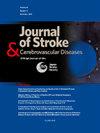颈动脉支架植入术后血流动力学抑制的危险因素:系统回顾和荟萃分析
IF 1.8
4区 医学
Q3 NEUROSCIENCES
Journal of Stroke & Cerebrovascular Diseases
Pub Date : 2025-05-06
DOI:10.1016/j.jstrokecerebrovasdis.2025.108340
引用次数: 0
摘要
目的颈动脉支架置入术治疗颈动脉狭窄时,血流动力学抑制(HD)是常见的临床不良事件。本综述旨在阐明HD的发病率和危险因素。方法我们检索了4个综合数据库,以报道CAS期间HD的发生率或危险因素。我们使用改良版的纽卡斯尔-渥太华量表来评估纳入研究的偏倚风险。我们汇总了HD患病率和相关危险因素,并使用随机效应模型进行了通用逆方差加权。我们使用OR报告结果,CI为95%。采用漏斗图和Egger检验评估发表偏倚。结果我们的荟萃分析纳入了53篇文章,发现HD的发病率为35%。糖尿病患者(OR = 1.28, 95% CI: 1.07 ~ 1.54), stenosis-to-bifurcation & lt; 10毫米(OR = 2.11, 95% CI: 1.29 ~ 3.48),涉及颈动脉狭窄灯泡(OR = 1.9, 95% CI: 1.07 ~ 3.38),钙化斑块(OR = 2.06, 95% CI: 1.32 ~ 3.22),偏心斑块(OR = 1.47, 95% CI: 1.05 ~ 2.05),严重狭窄(OR = 1.64, 95% CI: 1.1 ~ 2.43),侧狭窄(OR = 2.02, 95% CI: 1.18 ~ 3.46),开孔支架(OR = 1.5, 95% CI:1.04 ~ 2.15),双侧支架植入术(OR = 2.32, 95% CI: 1.56 ~ 3.44)的HD风险较高。结论糖尿病、狭窄至分叉(10mm)、颈动脉球囊狭窄、钙化斑块、偏心斑块、严重狭窄、对侧狭窄、开孔细胞支架和双侧颈动脉支架置入与动脉粥样硬化硬化相关。本文章由计算机程序翻译,如有差异,请以英文原文为准。
Risk factors for hemodynamic depression after carotid artery stenting: A system review and meta analysis
Purpose
Hemodynamic depression (HD) regularly occurs during carotid artery stenting(CAS) for treating carotid stenosis and it could result in adverse clinical events. This review aimed to clarify the incidence and risk factors for HD.
Methods
We searched four comprehensive databases for studies that reported the incidence or risk factors for HD during CAS. We used a modified version of Newcastle-Ottawa scale to assess the risk of bias in the included studies. We pooled the prevalence rates of HD and related risk factors from individual studies with a generic inverse variance weighted using the randomized effects model. We reported the results using OR with 95 % CI. Funnel plots and Egger’s tests were used to assess the publication bias.
Results
Our meta-analysis enrolled 53 articles and revealed that the incidence of HD was 35 %. Patients who had diabetes (OR = 1.28, 95 % CI: 1.07 to 1.54), stenosis-to-bifurcation <10 mm (OR = 2.11, 95 % CI: 1.29 to 3.48), stenosis involving the carotid bulb (OR = 1.9, 95 % CI: 1.07 to 3.38), calcified plaque (OR = 2.06, 95 % CI: 1.32 to 3.22), eccentric plaque (OR = 1.47, 95 % CI: 1.05 to 2.05), severe stenosis (OR = 1.64, 95 % CI: 1.1 to 2.43), contralateral stenosis (OR = 2.02, 95 % CI: 1.18 to 3.46), open-cell stents (OR = 1.5, 95 % CI: 1.04 to 2.15), and bilateral stenting (OR = 2.32, 95 % CI: 1.56 to 3.44) showed a higher risk of HD.
Conclusions
Diabetes, stenosis-to-bifurcation <10 mm, stenosis involving the carotid bulb, calcified plaque, eccentric plaque, severe stenosis, contralateral stenosis, open-cell stents, and bilateral carotid stenting were associated with HD during CAS.
求助全文
通过发布文献求助,成功后即可免费获取论文全文。
去求助
来源期刊

Journal of Stroke & Cerebrovascular Diseases
Medicine-Surgery
CiteScore
5.00
自引率
4.00%
发文量
583
审稿时长
62 days
期刊介绍:
The Journal of Stroke & Cerebrovascular Diseases publishes original papers on basic and clinical science related to the fields of stroke and cerebrovascular diseases. The Journal also features review articles, controversies, methods and technical notes, selected case reports and other original articles of special nature. Its editorial mission is to focus on prevention and repair of cerebrovascular disease. Clinical papers emphasize medical and surgical aspects of stroke, clinical trials and design, epidemiology, stroke care delivery systems and outcomes, imaging sciences and rehabilitation of stroke. The Journal will be of special interest to specialists involved in caring for patients with cerebrovascular disease, including neurologists, neurosurgeons and cardiologists.
 求助内容:
求助内容: 应助结果提醒方式:
应助结果提醒方式:


